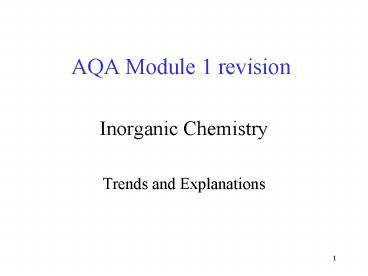AQA Module 1 revision - PowerPoint PPT Presentation
1 / 10
Title: AQA Module 1 revision
1
AQA Module 1 revision
- Inorganic Chemistry
- Trends and Explanations
2
The first ionisation energies of helium, neon and
argon are shown in the table.
Explain the variation in first ionisation energy
down Group 0.
As the group is descended each noble gas atom has
an extra electron shell so the outer electrons
are further from the nucleus and there is an
increasing amount of shielding from the inner
shells. Less attraction between the outer
electron and the nucleus means that less energy
is required to remove the electron so the first
ionisation energy decreases down the group.
3
The first, second and third ionisation energies
of calcium are shown in the table.
Why is there a large difference between the
values for the second and the third ionisation
energies of calcium?
In a Group 2 atom, the first two electrons are
removed relatively easily but the third electron
is removed from a different shell which is closer
to the nucleus. There is less shielding between
the outer electron and the nucleus which results
in stronger attraction so more energy is needed
to remove the third electron.
4
The graph shows the variation in atomic radius
across Period 3.
Explain the trend across the Period.
Across the Period, the outer electrons are in the
same principal quantum shell and the amount of
shielding remains roughly constant. The number of
protons increases resulting in a greater
attraction for the outer electrons so the atomic
radius is smaller.
5
The graph shows the variation in first ionisation
energy across period 3.
Explain why the first ionisation energy of Al is
less than Mg.
The outer electron is in the 3p sub-shell which
is better screened from the attractive force of
the nucleus than the 3s sub-shell.
Explain why the first ionisation energy of S is
less than P.
The paired electrons in the 3p sub-shell results
in repulsion which means that less energy is
required to remove the outer electron.
6
Explain why the Group 2 metals become more
reactive down the group.
Going down Group 2 the atomic radius increases so
the outer electrons are further from the
nucleus. This is because there is more shielding,
so the amount of energy required to remove the
outer electrons decreases. Therefore reactivity
increases as they all lose 2 outer electrons
during reactions.
7
Explain why the Group 7 elements become less
reactive down the group.
More shells are added down Group 7 so there is an
increasing amount of electron shielding and the
outer electron gets further from the nucleus. The
captured electron experiences less attraction
from the nucleus of the atom so electrons are
gained less easily and reactivity decreases.
8
The graph shows the variation in the melting
point of the elements across Period 3.
Why is the melting point of magnesium greater
than sodium?
As the number of outer electrons increases the
ionic charge increases and the metallic bonds get
stronger.
Why does silicon have a very high melting point?
It is a giant molecule with strong covalent bonds
between all the atoms.
Why are the melting points of P4, S8 and Cl2 very
low?
They have simple molecular structures with weak
intermolecular forces.
9
The graph shows the variation in the
electronegativity of the elements across Period 3.
Define the term electronegativity.
The ability of an atom to attract the bonding
electrons in a covalent bond.
Explain why electronegativity increases across
the period.
As the number of protons increases, and the
degree of screening is constant, the atoms are
better able to attract the bonding electrons.
10
Explain why magnesium chloride, MgCl2 has ionic
bonding.
The large difference in electronegativity between
the metal and non-metal elements leads to the
transfer of electrons forming positive and
negative ions.
Explain why the bonding in aluminium chloride,
AlCl3 is intermediate between ionic and covalent
bonding.
The small, highly charged positive ion polarises
the negative ions to introduce a lot of covalent
character into the bonds
Explain why phosphorus chloride, PCl3 has
covalent bonding.
The small difference in electronegativity between
the two non-metal elements leads to the sharing
of pairs of electrons between the atoms.































